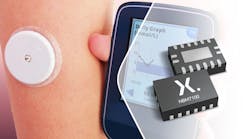This article is part of the TechXchange: Low-Power Battery Technology.
Lithium-ion (Li-ion) batteries are changing the game in everything from smartphones and smartwatches to electric vehicles (EVs) and storage systems that save solar, wind, and other renewable energy for the grid. Despite having large capacities, these batteries must be carefully managed to maximize the amount of power they can supply to their loads and reduce the time it takes to inevitably replenish them.
But carefully and efficiently managing power is even more important for the micro-batteries at the heart of many IoT devices. In many cases, they’re non-rechargeable and must be replaced after a single use.
Nexperia rolled out a family of power-management ICs (PMICs) that are specifically designed for lithium-based, coin-cell batteries and, thus, can increase their useful life by up to 10X compared to rival products. Dubbed the NBM7100 and NBM5100, they can also boost the peak output current of these small, round, metal-enclosed batteries by up to 25X compared to what they can do by themselves.
The order-of-magnitude improvement in battery life could turn these coin cells into a viable power source for wireless consumer and industrial IoT devices that now can only operate from AA or AAA batteries.
Nexperia has been trying to tackle the unique power-management needs of ultra-low-power IoT and even off-mains devices without batteries. In May, it rolled out its latest energy-harvesting IC that can efficiently convert microwatts to milliwatts of power from light, heat, vibrations, or other sources in the environment.
With relatively high energy densities and long shelf lives, coin-cell batteries are widely used in wireless sensors, wearables, and other IoT devices that operate at low duty cycles. These loads generally remain in standby for long intervals, only turning themselves on to sense their surroundings or transfer data. Therefore, instead of continuous power delivery, the loads require infrequent bursts of current, said Nexperia.
But these outbursts can also present challenges to coin-cell batteries. Their high internal resistance and chemical reaction rates cause their usable capacity to deteriorate faster under pulsed-load conditions.
Longer Lifecycle with DC-DC Conversion
To prolong the lifespan of these batteries, the NBM7100 and NBM5100 contain a pair of dc-dc conversion stages that together run at more than 90% efficiency. The first stage transfers current out of the battery to a storage capacitor at a low constant current. When charged, the secondary stage uses the stored energy to deliver a regulated (programmable from 1.8 to 3.6 V) high current up to 200 mA through the output pin.
The ICs, which can withstand a wide range of temperatures from −40 to 85°C, will also monitor the energy expended during repetitive load-pulse cycles and intelligently optimize the first dc-dc converter stage to minimize the residual charge in the system’s storage capacitor. While the new power ICs are in standby mode and not actively converting battery power, they waste less than 50 nA.
As a result, the coin cell itself is never directly subjected to large load pulse currents, resulting in a longer, more predictable battery lifespan, with a programmable constant battery load current of 2 to 16 mA.
Dan Jensen, head of the analog and logic unit at Nexperia, said the longer battery lives made possible by the intelligent PMICs means longer intervals between battery replacements. He explained that it “helps to reduce battery waste in IoT, wearables, and other consumer applications.”
The chips, which can also manage the output of the latest paper-printed batteries, are designed to alert the system when the battery reaches the end of its life. They protect against battery voltage drops (“brownouts”) as well, blocking the capacitor from being charged when the battery’s useful life is almost done. The NBM5100 has a voltage balancing pin to manage energy stored in supercapacitors.
A serial interface is included for configuration and control by a system microcontroller (MCU): the I2C in NMB7100A and NBM5100A and serial peripheral interface (SPI) bus in the NMB7100B and NBM5100B.
The new power-management ICs are suited for LiMnO2 and Li-SOCL2 batteries with output voltages of up to 3.6 V. They come in compact, 2.5- × 3.5- × 0.85-mm DHVQFN16 packages.
Read more articles in the TechXchange: Low-Power Battery Technology.
